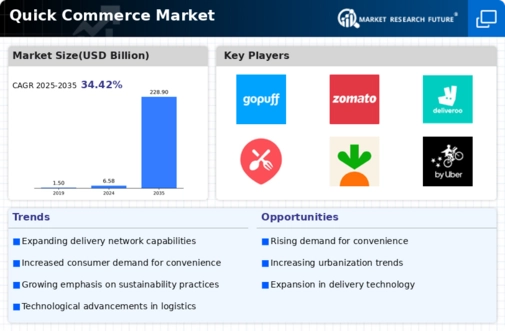Technological Advancements
Technological advancements play a pivotal role in shaping the Quick Commerce Market. The integration of artificial intelligence, machine learning, and data analytics has revolutionized the way businesses operate, enabling them to optimize inventory management and streamline delivery processes. For instance, predictive analytics allows companies to anticipate consumer demand, thereby reducing delivery times and improving service reliability. Furthermore, the proliferation of mobile applications has facilitated seamless user experiences, allowing consumers to place orders with ease. As technology continues to evolve, the Quick Commerce Market is likely to witness further enhancements in operational efficiency and customer engagement, ultimately driving growth and competitiveness.
Evolving Consumer Preferences
Evolving consumer preferences are reshaping the Quick Commerce Market, as individuals increasingly prioritize personalized and tailored shopping experiences. The rise of e-commerce has led consumers to expect not only speed but also customization in their purchasing journeys. Recent surveys indicate that nearly 70 percent of consumers are more likely to engage with brands that offer personalized recommendations and services. This shift compels businesses to leverage data analytics and customer insights to refine their offerings and enhance customer loyalty. As a result, the Quick Commerce Market is witnessing a transformation in how companies approach marketing and customer engagement, focusing on delivering value through personalized experiences.
Consumer Demand for Convenience
The Quick Commerce Market is experiencing a surge in consumer demand for convenience, as individuals increasingly seek rapid access to goods and services. This trend is evidenced by the growing preference for on-demand delivery services, which cater to the need for immediacy in everyday purchases. Recent data indicates that approximately 60 percent of consumers prioritize speed when selecting delivery options, thereby driving the expansion of quick commerce platforms. As a result, businesses are compelled to innovate their logistics and supply chain strategies to meet these evolving consumer expectations. The Quick Commerce Market is thus positioned to capitalize on this demand, with companies investing in technology and infrastructure to enhance delivery efficiency and customer satisfaction.
Urbanization and Population Density
Urbanization and increasing population density are significant drivers of the Quick Commerce Market. As more individuals migrate to urban areas, the demand for quick and efficient delivery services intensifies. Data suggests that urban populations are projected to grow by over 2 billion by 2050, creating a substantial market for quick commerce solutions. This demographic shift necessitates innovative logistics strategies to navigate congested urban environments and meet consumer expectations for rapid delivery. Consequently, businesses within the Quick Commerce Market are adapting their operations to cater to urban consumers, leveraging technology and localized fulfillment centers to enhance service delivery and maintain competitive advantage.
Competitive Landscape and Market Entry
The competitive landscape of the Quick Commerce Market is characterized by a proliferation of new entrants and established players vying for market share. This dynamic environment fosters innovation and drives companies to differentiate their services through unique value propositions. Recent trends indicate that investment in quick commerce startups has surged, with funding reaching unprecedented levels. This influx of capital enables new players to develop innovative solutions and challenge traditional retail models. As competition intensifies, businesses within the Quick Commerce Market are compelled to enhance their service offerings, improve operational efficiencies, and adopt agile business models to remain relevant and capture consumer attention.


















Leave a Comment